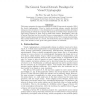IWANN
2001
Springer
14 years 12 months ago
2001
Springer
This paper proposes the general paradigm to build Q'tron neural networks (NNs) for visual cryptography. Given a visual encryption scheme, usually described using an access st...
EUROCRYPT
2001
Springer
14 years 12 months ago
2001
Springer
We formalize the notion of a cryptographic counter, which allows a group of participants to increment and decrement a cryptographic representation of a (hidden) numerical value pri...
CRYPTO
2001
Springer
14 years 12 months ago
2001
Springer
The OAEP encryption scheme was introduced by Bellare and Rogaway at Eurocrypt ’94. It converts any trapdoor permutation scheme into a public-key encryption scheme. OAEP is widel...
102
click to vote
EUROCRYPT
2010
Springer
15 years 7 days ago
2010
Springer
Imagine many small devices send data to a single receiver, encrypted using the receiver’s public key. Assume an adversary that has the power to adaptively corrupt a subset of the...
EUROCRYPT
2010
Springer
15 years 7 days ago
2010
Springer
We construct the first public-key encryption scheme that is proven secure (in the standard model, under standard assumptions) even when the attacker gets access to encryptions of ...
EUROCRYPT
2010
Springer
15 years 7 days ago
2010
Springer
We initiate a provable-security treatment of cryptographic agility. A primitive (for example PRFs, authenticated encryption schemes or digital signatures) is agile when multiple, ...
FSE
2003
Springer
15 years 19 days ago
2003
Springer
Abstract. This paper addresses the security of symmetric cryptosystems in the blockwise adversarial model. At Crypto 2002, Joux, Martinet and Valette have proposed a new kind of at...
EUROCRYPT
2003
Springer
15 years 19 days ago
2003
Springer
Abstract. In this paper we present a simpler construction of a publickey encryption scheme that achieves adaptive chosen ciphertext security (CCA2), assuming the existence of trapd...
EUROCRYPT
2003
Springer
15 years 19 days ago
2003
Springer
Cryptographic computations are often carried out on insecure devices for which the threat of key exposure represents a serious concern. Forward security allows one to mitigate the...
ASIACRYPT
2003
Springer
15 years 20 days ago
2003
Springer
In this paper, we study some RSA-based semantically secure encryption schemes (IND-CPA) in the standard model. We first derive the exactly tight one-wayness of Rabin-Paillier encr...


